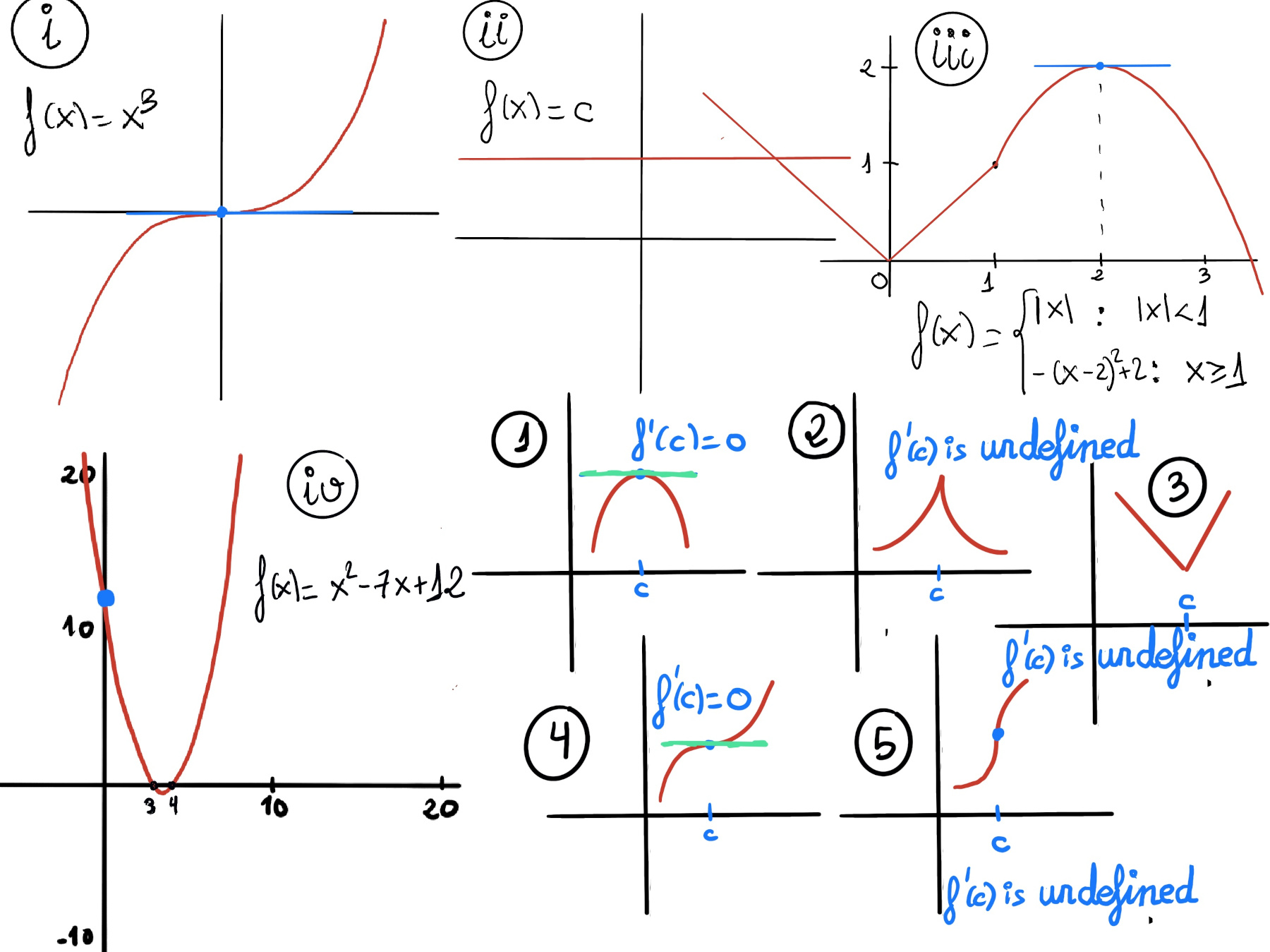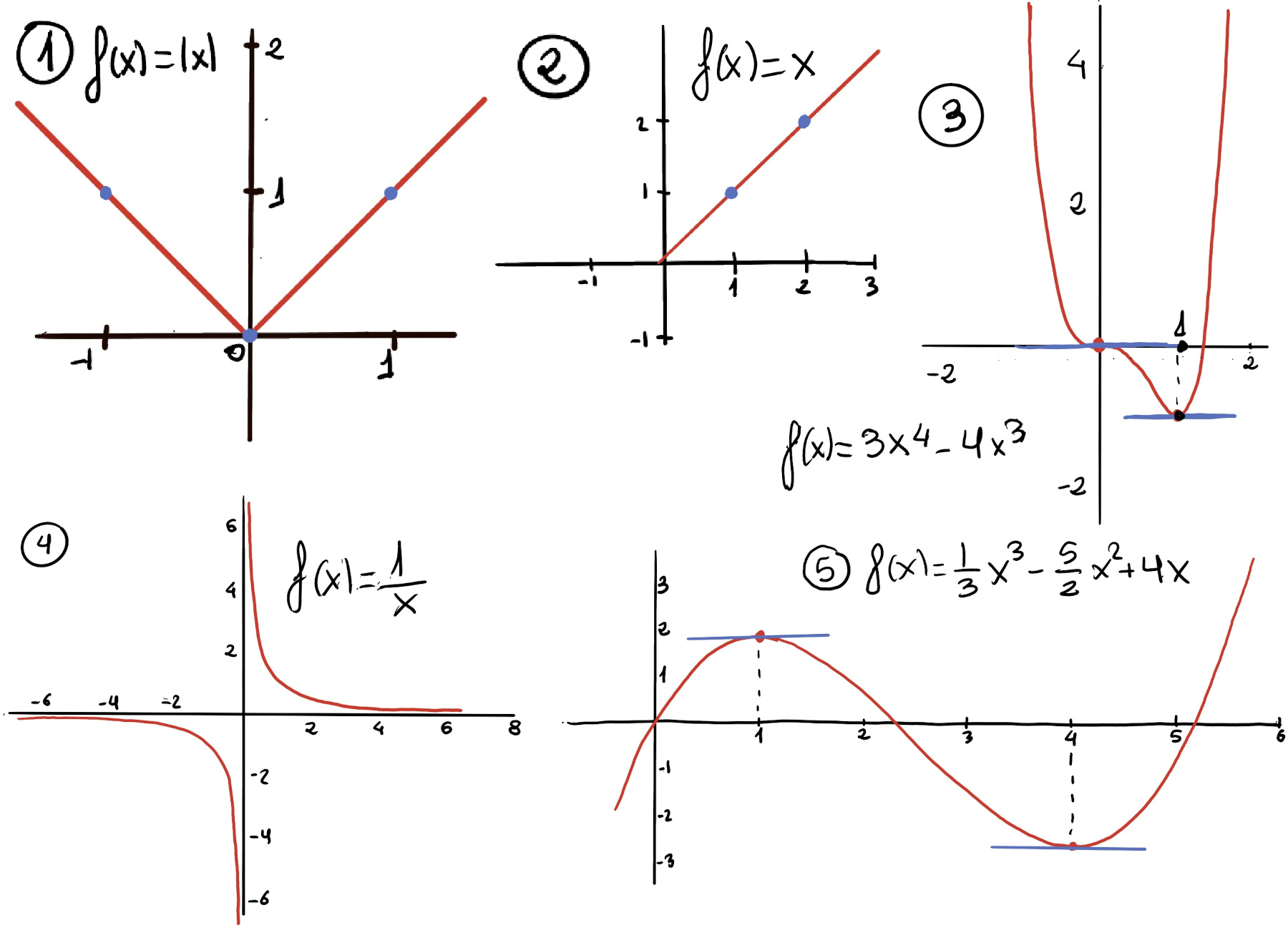
|
 |
 |

|
 |
 |
We shall go on to the end, we shall fight in France, we shall fight on the seas and oceans, we shall fight with growing confidence and growing strength in the air, we shall defend our island, whatever the cost may be. [···] We shall fight on the beaches, we shall fight on the landing grounds, we shall fight in the fields and in the streets, we shall fight in the hills; we shall never surrender, Winston Churchill.
The maxima and minima of a function, known collectively as extrema are the largest and smallest value of the function, either within a given range (the local or relative extrema), or on the entire domain (absolute extrema).
Notice that the definition of absolute extrema entails that an absolute extremum, unlike a relative extremum, may fall on an endpoint.
A critical point is a point in the domain of the function where the function is either not differentiable or the derivative is equal to zero. The value of the function at a critical point is called a critical value.
The squeeze or sandwich theorem. If a function f lies between two functions g and h, and the limits of each of them at a particular point are equal to L, then the limit of f at that particular point is also equal to L.
Formal definition. Let f, g, and h be functions defined on an interval I that contains x = a, except possibly at x = a. Suppose that for every x in I not equal to a, we have g(x) ≤ f(x) ≤ h(x), and also suppose that $\lim_{x \to a} g(x) = \lim_{x \to a} h(x) = L.$ Then, $\lim_{x \to a} f(x) = L.$
Extreme Value Theorem. If f is a continuous function on an interval [a,b], then f has both maximum and minimum values on [a,b]. It states that if a function is continuous on a closed bounded interval, then the function must have a maximum and a minimum on the interval (Figure 1.f.), you can see the proof at Extreme Value Theorem.
Fermat’s Theorem. If a function ƒ(x) is defined on the interval (a, b), it has a local extremum (relative extrema) on the interval at x = c, and ƒ′(c) exists, then x = c is a critical point of f(x) and f'(c) = 0 (Figure 1.a.)

Proof:
Let’s assume that f(x) has a relative maximum on the interval at x = c. The proof for a relative minimum is pretty identical. In other words, there is no loss of generality.
$f’(c)=\lim_{h \to 0}=\frac{f(c+h)-f(c)}{h}$=[By assumption, the limit exists] $\lim_{h \to 0^{+}}\frac{f(c+h)-f(c)}{h}≤0$ because we are dividing f(c+h)-f(c) ≤ 0 -c is a relative maximum. f(c) ≥ f(c+h)- and h>0 (Figure 1.b.). Therefore, f’(c) ≤ 0.
$f’(c)=\lim_{h \to 0}=\frac{f(c+h)-f(c)}{h}=\lim_{h \to 0^{-}}\frac{f(c+h)-f(c)}{h}≥0$ because we are dividing f(c+h)-f(c) ≤ 0 -c is a relative maximum- and h<0. Therefore, f’(c) ≥ 0. We have already shown that f’(c) ≤ 0 and f’(c) ≥ 0, so f’(c) = 0 ∎

Extreme cases. Constant functions, f(x) = c (Figure ii), are such that every point is critical (f’(x) = 0 ∀x ∈ ℝ), global and local maximum and minimum, and y = c is both the minimum and maximum value.
Consider the following piece-wise function, $f(x) = \begin{cases} |x|, &x < 1 \\ -(x - 2)^2 + 2, &x ≥ 1 \end{cases}$
$f’(x) = \begin{cases} -1, &x < 0 \\ 1, &0 < x < 1 \\ 2(x -2), &1 < x \end{cases}$
f has a local minimum at x = 0 and a local maximum at x = 2 and three critical points, namely 0 and 1 (because f’(0) and f’(1) are not defined), and 2 (f’(x) = 0 ↭ 2·(x-2) = 0↭ x = 2). Since f’(2) exists, we already knew that f’(2) = 0 (Figure iii).

If a function f is continuous on a closed interval, then the Extreme Value Theorem guarantees that f has both a maximum and a minimum value on that interval. By Fermat’s theorem, every local extremum in the interior of the domain of a differentiable function is necessarily a critical point. In our particular case (no critical values), this means that their extreme values can be found by evaluating the function at the endpoints of the interval.


f is continuous, so by the Extreme Value Theorem f has an absolute maximum and an absolute minimum. Critical points: 0 (f’(0) is undefined). Endpoints: (1, 1) and (-1, 1) ⇒[To find any absolute extrema, we can simply evaluate the function at 0 -critical point-, 1, and -1 -endpoints-] The absolute maximums are at the points x = ± 1 and the absolute minimum is at x = 0 on the interval [-1, 1].
0 ∈ [-1, 1] is a local extremum, but f’(0) does not exist. This is an example of (3) in a previous diagram, 0 ∈ [-1, 1] is a local extremum, but f'(0) does not exist.
f is continuous and differentiable, so by the Extreme Value Theorem f has an absolute maximum and an absolute minimum, but f’(x) = 1 ≠ 0 ⇒ no critical points ⇒ [To find any absolute extrema, we can simply evaluate the function at 1 and 2] f(1) = 1 is an absolute minimum and f(2) = 2 an absolute maximum on the interval [1, 2].

f is continuous and differentiable, so by the Extreme Value Theorem f has an absolute maximum and an absolute minimum. f’(x) = 12x3 -12x2 = 0 ↭ x(x -1) = 0 ↭ x = 0, 1 are critical points.
To find any absolute extrema, we can simply evaluate the function at its critical values (0 and 1) and the endpoints (-1 and 2), and we get (0, 0), (1, -1), (-1, 7) and (2, 16). Therefore, f has an absolute maximum at 2 (2, 16) and an absolute minimum at 1. This is an example of (4), f'(0) = 0, but f has not a local extrema on the interval [-1, 2] at x = 0.
f is not continuous at x = 0 ⇒ we cannot apply the Extreme Value Theorem. Futhermore, $\lim_{x \to 0⁺} \frac{1}{x} = ∞, \lim_{x \to 0⁻} \frac{1}{x} = -∞$ ⇒ f does not have any absolute extrema on [-1, 1].

f is continuous and differentiable, so by the Extreme Value Theorem, f has an absolute maximum and an absolute minimum. f’(x) = $x^2-5x +4 = (x-4)(x-1)$ ⇒ the critical points are 1 and 4.
To find any absolute extrema, we can simply evaluate the function at its critical values (1 and 4) and the endpoints (0 and 5), and we get (1, $\frac{11}{6}$≈1.83), (4, $\frac{-8}{3}$≈-2.66), (0, 0), (5, $\frac{-5}{6}$≈-0.83). Therefore, f has an absolute maximum at 1 (1, $\frac{11}{6}$≈1.83), and an absolute minimum at (4, $\frac{-8}{3}$≈-2.66) on the interval [0, 5].